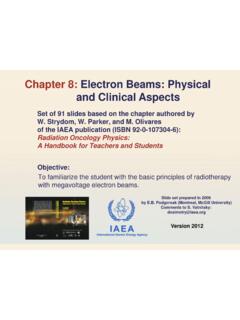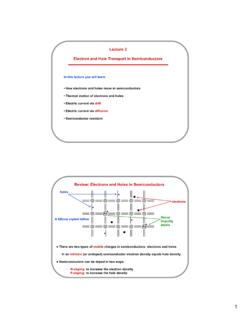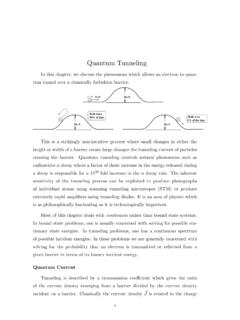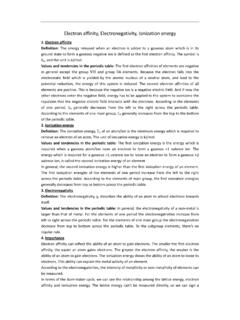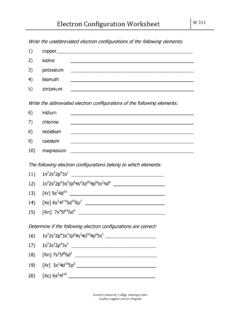Transcription of CHAPTER 10 AUGER ELECTRON SPECTROSCOPY
1 CHAPTER 10 AUGER ELECTRON SPECTROSCOPY Richard P. Gunawardane and Christopher R. Arumainayagam Department of Chemistry, Wellesley College, Wellesley, MA 02481, INTRODUCTION AUGER ELECTRON SPECTROSCOPY (AES) is a nondestructive core-level ELECTRON SPECTROSCOPY for semi-quantitative determination of the elemental composition of surfaces, thin films, and interfaces. The popularity of this ultrahigh vacuum technique may be attributed to high surface sensitivity (an analysis depth of less than 100 ) and a relatively low detection limit (~ atomic percent). In addition to having an elemental coverage from lithium to uranium and beyond, AES has the ability to distinguish between two elements that are close to each other in the periodic table.
2 In addition, AES has an atomic number-dependent sensitivity that varies at most by one order of magnitude. AES chemical shifts and line shapes can also yield bonding (chemical state) information, albeit with less precision than is possible with X-ray photoelectron SPECTROSCOPY (XPS) ( CHAPTER 11), another core-level ELECTRON SPECTROSCOPY . AUGER ELECTRON SPECTROSCOPY has a depth resolution of 5 25 , and can be used, with simultaneous ion sputtering, for depth profiling. With a lateral resolution (< 100 ) that is significantly better than that of XPS, scanning AUGER microscopy(SAM) can be used effectively for imaging nanoscale structures and to produce two-dimensional maps of surface elemental composition.
3 Survey AUGER spectra typically take less than five minutes, providing for rapid data acquisition. Although somewhat sophisticated and expensive, AUGER instrumentation is relatively simple to use and is readily available from many different commercial sources. The reasons enumerated above explain why AUGER ELECTRON SPECTROSCOPY has become perhaps the most widely used surface analytical technique. Recent developments in AES have expanded the scope of this technique beyond the probing of surface elemental composition. For example, spinpolari-zation of AUGER electrons can be used to study magnetized solid surfaces [1].
4 Moreover, results of resonant AUGER ELECTRON SPECTROSCOPY experiments provide information relevant to femtosecond charge transfer dynamics [2]. AUGER ELECTRON diffraction can also be used to determine surface 10. AUGER ELECTRON Spectroscopystructure [3]. Finally, results of recent experiments have demonstrated that angle-resolved AUGER ELECTRON SPECTROSCOPY can provide a means to study excitation processes in solids [4]. The AUGER process is a three- ELECTRON process. When a beam of electrons, typically with an energy range of 3 20 keV, strikes a solid atom, a core-level (inner) ELECTRON is ejected producing a singly ionized excited atom.
5 An outer level ELECTRON can fill the resulting vacancy in the core level. Following this radiationless transition, the excess energy of the resulting excited state ion may be removed by emitting either (i) an X-ray (the basis for X-ray fluorescence (XRF)/ ELECTRON microprobe (EMP) analysis) or (ii) another ELECTRON from the atom. The emitted electrons in process (ii) are called Augerelectrons, after Pierre AUGER , who discovered this process in the 1920s [5]. Although Lise Meitner independently discovered the effect around the same time [6], she is given very little recognition in the literature.
6 While the emission of X-rays (process (i)) produces singly ionized atoms, the emission of AUGER electrons (process (ii)) results in doubly ionized atoms. Because AUGER is a three- ELECTRON process, hydrogen and helium cannot be detected by this technique. Although Li has three electrons, an isolatedground state Li atom does not yield AUGER peaks because the atom has only two energy levels that contain electrons. AUGER peaks, however, have been detected from multiply excited Li atoms [7]. The presence of electrons in the valence band of solid Li also allows for AUGER transitions of the type KVV. The surface sensitivity of AES is due to the short mean free path of the relatively low energy AUGER electrons.
7 Although atomic excitations can take place to a depth of ~10,000 below the surface, the AUGER electrons from only the uppermost atomic layers, down to a depth of ~100 , are ejected from the specimen without undergoing any energy loss. In contrast, ELECTRON microprobe analysis, involving the detection of X-ray photons, is more of a bulk, rather than a surface, analysis tool (Figure ). Because of the very short lifetime of the electronic states associated with the AUGER process, the AUGER peaks are relatively wide (typically 1 2 eV), consistent with Heisenberg s uncertainty principle.
8 The kinetic energies of the AUGER electrons are characteristic of each emitting atom. Thus, the measurement of the kinetic energies of AUGER electrons can be used to identify the elements present on the surface of the sample. Because the kinetic energies of AUGER electrons depend on the binding energies of the ELECTRON levels involved in the AUGER process, the shifts in these kinetic energies can, in principle, provide useful information on the oxidation states and bonding environment of the surface atoms. In addition to the above qualitative analysis, quantitative information may also be determined from the intensities of the AUGER AUGER spectrum is represented as a plot of the number of electrons detected as a function of ELECTRON kinetic energy.
9 However, to make the small AUGER peaks more prominent, often AES spectra are displayed as the first derivative of the number of electrons emitted as a function of ELECTRON Introduction kinetic energy. The derivative form of the AUGER spectrum enhances the AUGER peaks and suppresses the background arising from the secondary and backscattered electrons. Figure Schematic diagram showing the various locations and outcomes of ELECTRON -solid interactions (a composite diagram based on various sources) [8, 9]. The AES analysis is carried out in an ultrahigh vacuum (UHV) chamber in which a pressure of ~10 9 torr or below is continuously maintained.
10 High vacuum is necessary to allow uninterrupted passage of the ELECTRON beam and ultrahigh vacuum is necessary to avoid contamination of the surface by atmospheric gases during analysis. The goal of this CHAPTER is to provide a detailed introduction to AUGER ELECTRON SPECTROSCOPY . Topics covered emphasize physical principles, experimental techniques and procedures, research and industrial applications, and new developments in AUGER ELECTRON SPECTROSCOPY . For a more detailed treatment of the technique and its applications, the reader is referred to a 900-page comprehensive treatise on AUGER and X-ray photoelectron SPECTROSCOPY published recently [10].




